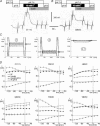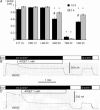The role of the third extracellular loop of the Na+,K+-ATPase alpha subunit in a luminal gating mechanism
- PMID: 15774534
- PMCID: PMC1464502
- DOI: 10.1113/jphysiol.2004.080218
The role of the third extracellular loop of the Na+,K+-ATPase alpha subunit in a luminal gating mechanism
Abstract
Na+,K+-ATPase is responsible for maintaining the cross-membrane Na+ and K+ gradients of animal cells. This P-type ATPase works via a complex transport cycle, during which it binds and occludes three intracellular Na+ ions and then two extracellular K+ ions, which it then releases on the other side of the membrane. The cation pathway through the protein, and the structures responsible for occluding cations inside the protein, have not yet been definitely identified. We used cysteine mutagenesis to explore the accessibility and the role of five conserved residues in the short third extracellular loop, between the fifth and the sixth transmembrane helices. The P801C and L802C mutants were not affected by extracellular sulfhydryl reagents. The presence of cysteine residues at three positions (G803C, T804C and V805C) conferred sensitivity to omeprazole, a known inhibitor of the gastric proton pump, and to [2-(trimethylammonium)-ethyl]methanethiosulphonate bromide (MTSET). The effects of omeprazole and MTSET were modulated by the presence of extracellular K+, indicating that the accessibility of these positions depended on the conformational state of the protein. MTSET binding to cysteine at position 803 partially inhibited the Na+,K+-pump function by decreasing its affinity towards extracellular K+, suggesting a restriction of the access of extracellular K+ ions to their binding sites. In contrast, MTSET binding to cysteine at position 805 partially inhibited the Na+,K+-pump function by reducing its maximum turnover rate, probably by slowing a rate-limiting conformational change. These residues occupy positions that are critical for either the cation pathway or the conformational modifications.
Figures





Similar articles
-
Access of extracellular cations to their binding sites in Na,K-ATPase: role of the second extracellular loop of the alpha subunit.J Gen Physiol. 2006 Mar;127(3):341-52. doi: 10.1085/jgp.200509418. J Gen Physiol. 2006. PMID: 16505152 Free PMC article.
-
The fourth transmembrane segment of the Na,K-ATPase alpha subunit: a systematic mutagenesis study.J Biol Chem. 2004 Jul 9;279(28):29542-50. doi: 10.1074/jbc.M400585200. Epub 2004 Apr 28. J Biol Chem. 2004. PMID: 15123699
-
Mercury binding site on Na+/K(+)-ATPase: a cysteine in the first transmembrane segment.Mol Pharmacol. 1996 Sep;50(3):687-91. Mol Pharmacol. 1996. PMID: 8794911
-
Structure and mechanism of Na,K-ATPase: functional sites and their interactions.Annu Rev Physiol. 2003;65:817-49. doi: 10.1146/annurev.physiol.65.092101.142558. Epub 2002 May 1. Annu Rev Physiol. 2003. PMID: 12524462 Review.
-
Polarized membrane distribution of potassium-dependent ion pumps in epithelial cells: different roles of the N-glycans of their beta subunits.Cell Biochem Biophys. 2007;47(3):376-91. doi: 10.1007/s12013-007-0033-6. Cell Biochem Biophys. 2007. PMID: 17652782 Review.
Cited by
-
Acidic residues of extracellular loop 3 of the Na+/H+ exchanger type 1 are important in cation transport.Mol Cell Biochem. 2020 May;468(1-2):13-20. doi: 10.1007/s11010-020-03707-9. Epub 2020 Mar 4. Mol Cell Biochem. 2020. PMID: 32130622
-
Access of extracellular cations to their binding sites in Na,K-ATPase: role of the second extracellular loop of the alpha subunit.J Gen Physiol. 2006 Mar;127(3):341-52. doi: 10.1085/jgp.200509418. J Gen Physiol. 2006. PMID: 16505152 Free PMC article.
-
Ouabain affinity determining residues lie close to the Na/K pump ion pathway.Proc Natl Acad Sci U S A. 2006 Aug 15;103(33):12613-8. doi: 10.1073/pnas.0602720103. Epub 2006 Aug 7. Proc Natl Acad Sci U S A. 2006. PMID: 16894161 Free PMC article.
-
The Alpha-1 Subunit of the Na+/K+-ATPase (ATP1A1) Is a Host Factor Involved in the Attachment of Porcine Epidemic Diarrhea Virus.Int J Mol Sci. 2023 Feb 16;24(4):4000. doi: 10.3390/ijms24044000. Int J Mol Sci. 2023. PMID: 36835408 Free PMC article.
-
Analysis of the gastric H,K ATPase for ion pathways and inhibitor binding sites.Biochemistry. 2007 May 8;46(18):5398-417. doi: 10.1021/bi062305h. Epub 2007 Apr 11. Biochemistry. 2007. PMID: 17425287 Free PMC article.
References
-
- Besancon M, Simon A, Sachs G, Shin JM. Sites of reaction of the gastric H,K-ATPase with extracytoplasmic thiol reagents. J Biol Chem. 1997;272:22438–22446. - PubMed
-
- Burns EL, Price EM. Random mutagenesis of the sheep Na,K-ATPase α–1 subunit generates a novel T797N mutation that results in an ouabain-resistant enzyme. J Biol Chem. 1993;268:25632–25635. - PubMed
-
- Feng J, Lingrel JB. Analysis of amino acid residues in the H5-H6 transmembrane and extracellular domains of Na,K-ATPase α subunit identifies threonine 797 as a determinant of ouabain sensitivity. Biochemistry. 1994;33:4218–4224. - PubMed
-
- Gadsby DC, Kimura J, Noma A. Voltage dependence of Na/K pump current in isolated heart cells. Nature. 1985;315:63–65. 10.1038/315063a0. - DOI - PubMed
Publication types
MeSH terms
Substances
LinkOut - more resources
Full Text Sources

